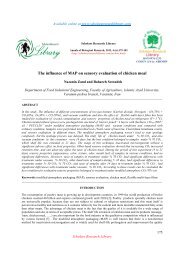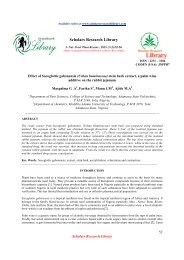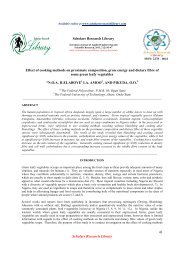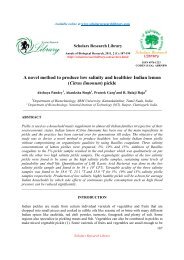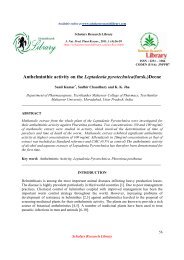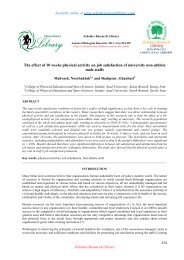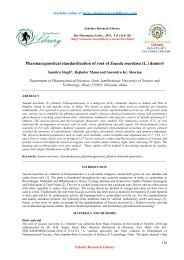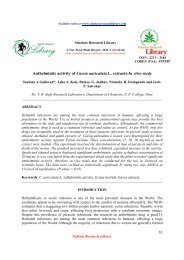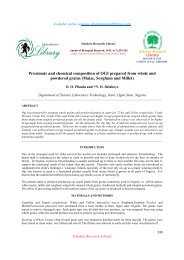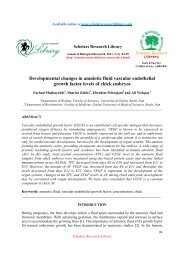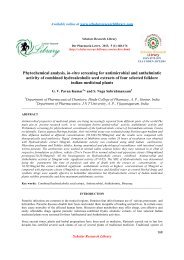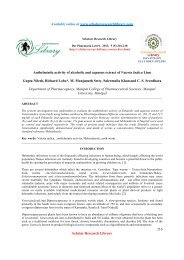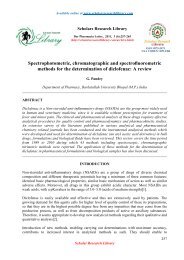Safety and regulatory issues on sunscreen products in India
Safety and regulatory issues on sunscreen products in India
Safety and regulatory issues on sunscreen products in India
You also want an ePaper? Increase the reach of your titles
YUMPU automatically turns print PDFs into web optimized ePapers that Google loves.
Available <strong>on</strong>l<strong>in</strong>e at www.scholarsresearchlibrary.com<br />
Scholars Research Library<br />
Archives of Applied Science Research, 2013, 5 (2):145-153<br />
(http://scholarsresearchlibrary.com/archive.html)<br />
ISSN 0975-508X<br />
CODEN (USA) AASRC9<br />
<str<strong>on</strong>g>Safety</str<strong>on</strong>g> <str<strong>on</strong>g>and</str<strong>on</strong>g> <str<strong>on</strong>g>regulatory</str<strong>on</strong>g> <str<strong>on</strong>g>issues</str<strong>on</strong>g> <strong>on</strong> <strong>sunscreen</strong> <strong>products</strong> <strong>in</strong> <strong>India</strong><br />
Sujit Kumar* <str<strong>on</strong>g>and</str<strong>on</strong>g> Roop Narayan Gupta<br />
Department of Pharmaceutical Sciences, Birla Institute of Technology, Mesra, Ranchi, Jharkh<str<strong>on</strong>g>and</str<strong>on</strong>g>, <strong>India</strong><br />
_____________________________________________________________________________________________<br />
ABSTRACT<br />
Sunscreens are <strong>products</strong> that are placed <strong>in</strong> c<strong>on</strong>tact with human sk<strong>in</strong> with the <strong>in</strong>tenti<strong>on</strong> of absorb<strong>in</strong>g, scatter<strong>in</strong>g, or<br />
reflect<strong>in</strong>g solar UV radiati<strong>on</strong>. Their frequency of use has <strong>in</strong>creased remarkably <strong>in</strong> <strong>India</strong> due to greater awareness of<br />
the damag<strong>in</strong>g effects of sk<strong>in</strong> exposure to sunlight. Sunscreen chemicals (UV filters) are used not <strong>on</strong>ly to protect the<br />
sk<strong>in</strong> of the user but also to prevent the product from photo-degradati<strong>on</strong>. Sunscreen chemicals <str<strong>on</strong>g>and</str<strong>on</strong>g> <strong>products</strong> are<br />
regulated as cosmetic or drug depend<strong>in</strong>g up<strong>on</strong> the regulati<strong>on</strong> of the country <strong>in</strong> which it is manufactured. Adverse<br />
effects due to <strong>sunscreen</strong> chemicals are of c<strong>on</strong>cern all over the world. Variati<strong>on</strong> <strong>in</strong> the regulati<strong>on</strong> affects the safety<br />
assessment of UV filters <str<strong>on</strong>g>and</str<strong>on</strong>g> its <strong>products</strong>. Amendments are required <strong>in</strong> the exist<strong>in</strong>g regulati<strong>on</strong> <strong>in</strong> this country.<br />
Key words: Sunscreen chemicals (UV filters), regulati<strong>on</strong>, drug, cosmetic, adverse effects.<br />
_____________________________________________________________________________________________<br />
INTRODUCTION<br />
Ultra violet (UV) radiati<strong>on</strong> <strong>in</strong> the Earth's surface is <strong>in</strong> the 290–400 nm wave length <str<strong>on</strong>g>and</str<strong>on</strong>g> is c<strong>on</strong>venti<strong>on</strong>ally divided<br />
<strong>in</strong>to UVA (320–400 nm) <str<strong>on</strong>g>and</str<strong>on</strong>g> UVB (290–320 nm) . UVA causes direct tann<strong>in</strong>g, photo-oxidati<strong>on</strong> of melan<strong>in</strong> <str<strong>on</strong>g>and</str<strong>on</strong>g><br />
premature sk<strong>in</strong> ag<strong>in</strong>g. Whereas UVB causes sunburn <str<strong>on</strong>g>and</str<strong>on</strong>g> are the major cause of sk<strong>in</strong> photo carc<strong>in</strong>ogenesis <str<strong>on</strong>g>and</str<strong>on</strong>g><br />
immunosuppressi<strong>on</strong> [1-3]. Sunburns <strong>in</strong> childhood are associated with melanoma <strong>in</strong> later life [4]. World Health<br />
organizati<strong>on</strong> has also classified UV radiati<strong>on</strong> as carc<strong>in</strong>ogenic which produces mutagenic effects, immune depressi<strong>on</strong><br />
of the sk<strong>in</strong> <str<strong>on</strong>g>and</str<strong>on</strong>g> the organism, accelerated sk<strong>in</strong> age<strong>in</strong>g <str<strong>on</strong>g>and</str<strong>on</strong>g> photo-dermatoses [5]. Chr<strong>on</strong>ic exposure to solar<br />
irradiati<strong>on</strong> is the primary cause of extr<strong>in</strong>sic sk<strong>in</strong> ag<strong>in</strong>g <str<strong>on</strong>g>and</str<strong>on</strong>g> is resp<strong>on</strong>sible for the ma<strong>in</strong> age-related alterati<strong>on</strong>s, such as<br />
roughness, f<strong>in</strong>e wr<strong>in</strong>kles, spotty hyperpigmentati<strong>on</strong>, vasodilatati<strong>on</strong>, <str<strong>on</strong>g>and</str<strong>on</strong>g> loss of sk<strong>in</strong> elasticity [6]. Dur<strong>in</strong>g the past<br />
decades, sk<strong>in</strong> cancer has become the most frequent neoplastic disease of the Caucasian populati<strong>on</strong> of Europe, North<br />
America <str<strong>on</strong>g>and</str<strong>on</strong>g> Australia. Products c<strong>on</strong>ta<strong>in</strong><strong>in</strong>g <strong>sunscreen</strong> chemicals (UV filters) are used to filter certa<strong>in</strong> UV rays <strong>in</strong><br />
order to protect the sk<strong>in</strong> from certa<strong>in</strong> harmful effect of these rays. In additi<strong>on</strong> to this sun-screen chemicals are also<br />
be<strong>in</strong>g <strong>in</strong>corporated <strong>in</strong> different cosmetic <strong>products</strong> like moisturizers, body loti<strong>on</strong>s, shower gels, shampoos, hair dyes,<br />
c<strong>on</strong>diti<strong>on</strong>ers, lip balm, lipstick, anti-ag<strong>in</strong>g creams etc. to stop photo degradati<strong>on</strong> of the <strong>products</strong>.<br />
UV filters are physical (<strong>in</strong>organic) or chemical (organic). Inorganic <strong>in</strong>gredients c<strong>on</strong>sist of metal derivatives,<br />
especially z<strong>in</strong>c oxide (ZnO) <str<strong>on</strong>g>and</str<strong>on</strong>g> titanium dioxide (TiO 2 ), which reflect, absorb <str<strong>on</strong>g>and</str<strong>on</strong>g> disperse most UV rays <str<strong>on</strong>g>and</str<strong>on</strong>g> are<br />
generally stable. Organic <strong>sunscreen</strong>s are synthetic chemicals that absorb UV energy by virtue of their molecular<br />
structure. These generally c<strong>on</strong>ta<strong>in</strong> aromatic r<strong>in</strong>gs that absorb radiati<strong>on</strong> of certa<strong>in</strong> wavelengths. The <strong>sunscreen</strong> loose a<br />
degree of efficiency over time <str<strong>on</strong>g>and</str<strong>on</strong>g> this leads to breakdown of the absorb<strong>in</strong>g molecule. S<strong>in</strong>ce these molecules are<br />
small, they may penetrate the sk<strong>in</strong> <str<strong>on</strong>g>and</str<strong>on</strong>g> cause systemic effects. Certa<strong>in</strong> chemical <strong>in</strong>gredients may also act as haptens<br />
<str<strong>on</strong>g>and</str<strong>on</strong>g> become complete antigens, caus<strong>in</strong>g sensitizati<strong>on</strong> reacti<strong>on</strong>s.<br />
In a tropical country like <strong>India</strong>, where the ambient UV radiati<strong>on</strong> levels <strong>in</strong> sunlight is greater than other areas [7] <str<strong>on</strong>g>and</str<strong>on</strong>g><br />
most of the human activities are sunlight oriented <strong>sunscreen</strong> <strong>products</strong> are rout<strong>in</strong>ely used by the people particularly <strong>in</strong><br />
urban areas. Many recent reports from Europe <str<strong>on</strong>g>and</str<strong>on</strong>g> other western countries have highlighted <strong>in</strong>creas<strong>in</strong>g cases of<br />
allergic <str<strong>on</strong>g>and</str<strong>on</strong>g> photo allergic reacti<strong>on</strong>s to <strong>sunscreen</strong> <strong>products</strong> [8, 9]. Most reports of patients of photo allergic dermatitis<br />
Scholars Research Library<br />
145
Sujit Kumar et al Arch. Appl. Sci. Res., 2013, 5 (2):145-153<br />
_____________________________________________________________________________<br />
or cosmetic allergy reveal close to 20% of them be<strong>in</strong>g attributed to <strong>sunscreen</strong> agents [10]. This article analyzes the<br />
<str<strong>on</strong>g>regulatory</str<strong>on</strong>g> <str<strong>on</strong>g>and</str<strong>on</strong>g> safety <str<strong>on</strong>g>issues</str<strong>on</strong>g> <strong>on</strong> <strong>sunscreen</strong> <strong>in</strong>gredients <str<strong>on</strong>g>and</str<strong>on</strong>g> its <strong>products</strong> <strong>in</strong> <strong>India</strong> with respect to other nati<strong>on</strong>s <str<strong>on</strong>g>and</str<strong>on</strong>g><br />
suggests suitable amendments <strong>in</strong> Drugs <str<strong>on</strong>g>and</str<strong>on</strong>g> Cosmetics Act 1940 <str<strong>on</strong>g>and</str<strong>on</strong>g> Rules 1945.<br />
REGULATORY OVERVIEW<br />
The first "<strong>sunscreen</strong> creams" were marketed <strong>in</strong> the 1930s <strong>in</strong> Europe <str<strong>on</strong>g>and</str<strong>on</strong>g> USA when sunbath<strong>in</strong>g became fashi<strong>on</strong>able<br />
[11]. Later <strong>in</strong> Germany <str<strong>on</strong>g>and</str<strong>on</strong>g> France, para-am<strong>in</strong>obenzoic acid (PABA) was patented <str<strong>on</strong>g>and</str<strong>on</strong>g> widely used as <strong>in</strong>gredient <strong>in</strong><br />
<strong>sunscreen</strong>s <strong>in</strong> 1943 [12].<br />
Sunscreens are regulated <strong>in</strong> all developed countries. The list of substances classified as UV filters <str<strong>on</strong>g>and</str<strong>on</strong>g> the maximum<br />
allowable c<strong>on</strong>centrati<strong>on</strong> are established by each country, for example, European Uni<strong>on</strong> (EU), United States of<br />
America (USA), Australia, Canada, ASEAN <str<strong>on</strong>g>and</str<strong>on</strong>g> <strong>India</strong>. UV filters approved <strong>in</strong> <strong>India</strong> <str<strong>on</strong>g>and</str<strong>on</strong>g> other nati<strong>on</strong>s are<br />
summarised as Table I.<br />
In the EU, <strong>sunscreen</strong> chemicals (UV filters) are classified as cosmetics (subject to positive list) [13, 14]. The lists<br />
are updated <strong>on</strong> the basis of scientific research <str<strong>on</strong>g>and</str<strong>on</strong>g> approved by The European Cosmetics Associati<strong>on</strong>, a body that<br />
liaises with the European Commissi<strong>on</strong>.<br />
In the USA, sun <strong>products</strong> are classified as over-the-counter drugs, a class for which it is necessary to <strong>in</strong>dicate active<br />
<strong>in</strong>gredients dem<strong>on</strong>strated to be effective <str<strong>on</strong>g>and</str<strong>on</strong>g> safe. Producti<strong>on</strong> <str<strong>on</strong>g>and</str<strong>on</strong>g> market<strong>in</strong>g of these <strong>products</strong> is regulated by US<br />
FDA m<strong>on</strong>ographs published <strong>in</strong> the Federal Register. These m<strong>on</strong>ographs have been c<strong>on</strong>stantly updated s<strong>in</strong>ce 1978.<br />
Sunscreen chemicals like dioxybenz<strong>on</strong>e, c<strong>in</strong>oxate, menthyl anthranilate,, trolam<strong>in</strong>e salicylate, z<strong>in</strong>c oxide are<br />
approved <strong>in</strong> USA but not <strong>in</strong> <strong>India</strong> [15, 16].<br />
In Canada, Sunscreen <strong>products</strong> are classified as prescripti<strong>on</strong> drugs <str<strong>on</strong>g>and</str<strong>on</strong>g> must meet the requirements set out <strong>in</strong><br />
Canada's Food <str<strong>on</strong>g>and</str<strong>on</strong>g> Drugs Act before they may be imported, advertised, or sold <strong>in</strong> Canada. Sunscreens are classified<br />
as natural health <strong>products</strong> (NHPs) if they c<strong>on</strong>ta<strong>in</strong> <strong>in</strong>gredients like titanium oxide, z<strong>in</strong>c oxide <str<strong>on</strong>g>and</str<strong>on</strong>g> para am<strong>in</strong>o benzoic<br />
acid.. Sunscreens are classified as drugs if they c<strong>on</strong>ta<strong>in</strong> at least <strong>on</strong>e <strong>in</strong>gredient from Avobenz<strong>on</strong>e, Ensulizole,<br />
Homosalate, Meradimate, Oct<strong>in</strong>oxate, Octisalate, Octocrylene, Oxybenz<strong>on</strong>e, Sulisobenz<strong>on</strong>e, Drometrizole<br />
trisiloxane, Enzacamene, Padimate-O, Terephthalylidene dicamphor sulf<strong>on</strong>ic acid, C<strong>in</strong>oxate, Diethanolam<strong>in</strong>emethoxyc<strong>in</strong>namate,<br />
Dioxybenz<strong>on</strong>e <str<strong>on</strong>g>and</str<strong>on</strong>g> Triethanolam<strong>in</strong>e salicylate. Health Canada has recently announced the<br />
release of the draft of revised Sunburn Protectants M<strong>on</strong>ograph. The document is now titled “Guidance Document<br />
Sunscreen M<strong>on</strong>ograph”, to reflect the comm<strong>on</strong> Canadian term for this category of drugs. It is the result of a<br />
thorough survey of exist<strong>in</strong>g regulati<strong>on</strong>s, guidance documents, policies <str<strong>on</strong>g>and</str<strong>on</strong>g> current practices with<strong>in</strong> Health Canada<br />
<str<strong>on</strong>g>and</str<strong>on</strong>g> other lead<strong>in</strong>g <str<strong>on</strong>g>regulatory</str<strong>on</strong>g> agencies. This draft M<strong>on</strong>ograph is <strong>in</strong>tended to replace the exist<strong>in</strong>g Sunburn Protectants<br />
M<strong>on</strong>ograph of October 12, 2006 [17]. Canada approves additi<strong>on</strong>al <strong>sunscreen</strong> chemicals as dioxybenz<strong>on</strong>e, c<strong>in</strong>oxate,<br />
menthyl anthranilate, diethanolam<strong>in</strong>e methoxyc<strong>in</strong>namate. ethyl dihydroxy propyl PABA , glyceryl PABA, trolam<strong>in</strong>e<br />
salicylate, z<strong>in</strong>c oxide are not <strong>in</strong>cluded <strong>in</strong> the UV filters list <strong>in</strong> <strong>India</strong>.<br />
Australia has <strong>on</strong>e of the highest rates of sk<strong>in</strong> cancer <strong>in</strong> the world, <str<strong>on</strong>g>and</str<strong>on</strong>g> <strong>sunscreen</strong>s are an important comp<strong>on</strong>ent of a<br />
sun protecti<strong>on</strong> regime. Many Australians use <strong>sunscreen</strong> every day of their lives, sometimes over large areas of their<br />
body surface. For safe, effective <str<strong>on</strong>g>and</str<strong>on</strong>g> quality <strong>sunscreen</strong> <strong>products</strong>, the TGA regulates some <strong>sunscreen</strong>s as therapeutic<br />
goods <strong>in</strong> Australia. Sun screen<strong>in</strong>g agents permitted as active <strong>in</strong>gredients <strong>in</strong> listed Products have been corrected <strong>in</strong><br />
2006 by TGA [18]. The Australian <str<strong>on</strong>g>regulatory</str<strong>on</strong>g> guidel<strong>in</strong>es for <strong>sunscreen</strong>s (ARGS) have been developed to provide<br />
guidance to sp<strong>on</strong>sors <str<strong>on</strong>g>and</str<strong>on</strong>g> manufacturers, <str<strong>on</strong>g>and</str<strong>on</strong>g> to assist <strong>in</strong> the underst<str<strong>on</strong>g>and</str<strong>on</strong>g><strong>in</strong>g of the <str<strong>on</strong>g>regulatory</str<strong>on</strong>g> requirements for<br />
<strong>sunscreen</strong>s <strong>in</strong> Australia [19]. SPF rat<strong>in</strong>g of 30+ may claim to prevent or reduce the risk of some sk<strong>in</strong> cancers. There<br />
are different classificati<strong>on</strong>s for <strong>sunscreen</strong>s like “listable”, “registrable” <str<strong>on</strong>g>and</str<strong>on</strong>g> “exempt” <strong>sunscreen</strong>s depend<strong>in</strong>g <strong>on</strong> the<br />
SPF rat<strong>in</strong>g. Where SPF is 4 or greater <str<strong>on</strong>g>and</str<strong>on</strong>g> claims are limited to <strong>sunscreen</strong><strong>in</strong>g <strong>on</strong>ly are listable <strong>sunscreen</strong>s.<br />
Sunscreens that make therapeutic claims are registrable <strong>sunscreen</strong>s. Only approved <strong>in</strong>gredients can be <strong>in</strong>cluded <strong>in</strong><br />
<strong>sunscreen</strong>s, <str<strong>on</strong>g>and</str<strong>on</strong>g> each of these <strong>in</strong>gredients has been assessed for safety. The TGA requires the efficacy of each<br />
<strong>sunscreen</strong> product to be tested to determ<strong>in</strong>e the sun protecti<strong>on</strong> factor (SPF), which is pr<strong>in</strong>ted <strong>on</strong> the label. UV filters<br />
like benzophen<strong>on</strong>e-1, benzophen<strong>on</strong>e-2, benzophen<strong>on</strong>e-4, dioxybenz<strong>on</strong>e, c<strong>in</strong>oxate, menthyl anthranilate, alpha-(2-<br />
oxoborn-3-ylidene) toluene-4-sulph<strong>on</strong>ic acid <str<strong>on</strong>g>and</str<strong>on</strong>g> its salts, salicylic acid salts (potassium, sodium <str<strong>on</strong>g>and</str<strong>on</strong>g><br />
triethanolam<strong>in</strong>e), triethanolam<strong>in</strong>e salicylate, z<strong>in</strong>c oxide, bemotriz<strong>in</strong>ol (t<strong>in</strong>osorb S), 2,2'-Methylene-bis-6-(2-Hbenzotriazol-2yl)-4-(tetramethylbutyl)-1,1,3,3-phenol<br />
(t<strong>in</strong>osorb M) are approved <strong>in</strong> Australia but not listed <strong>in</strong> <strong>India</strong><br />
[20].<br />
ASEAN has listed UV filters which cosmetic <strong>products</strong> may c<strong>on</strong>ta<strong>in</strong> <strong>in</strong> Annex VII of ASEAN cosmetic Document,<br />
published <strong>in</strong> 2009. Document requires that the c<strong>on</strong>diti<strong>on</strong>s of use <str<strong>on</strong>g>and</str<strong>on</strong>g> warn<strong>in</strong>gs must be pr<strong>in</strong>ted <strong>on</strong> the label as “do<br />
Scholars Research Library<br />
146
Sujit Kumar et al Arch. Appl. Sci. Res., 2013, 5 (2):145-153<br />
_____________________________________________________________________________<br />
not stay too l<strong>on</strong>g <strong>in</strong> the sun, even while us<strong>in</strong>g a <strong>sunscreen</strong> product”. Menthyl anthranilate <str<strong>on</strong>g>and</str<strong>on</strong>g> z<strong>in</strong>c oxide are not<br />
<strong>in</strong>cluded <strong>in</strong> the UV filters list <strong>in</strong> <strong>India</strong> [21].<br />
In <strong>India</strong>, Bureau of <strong>India</strong>n St<str<strong>on</strong>g>and</str<strong>on</strong>g>ards (BIS) has listed permitted UV filters which cosmetic <strong>products</strong> may c<strong>on</strong>ta<strong>in</strong><br />
[22]. There is no maximum SPF rat<strong>in</strong>g. For the purpose of this Directive, UV filters are substances, which<br />
c<strong>on</strong>ta<strong>in</strong>ed <strong>in</strong> cosmetic <strong>sunscreen</strong> <strong>products</strong>, are specifically <strong>in</strong>tended to filter certa<strong>in</strong> UV rays <strong>in</strong> order to protect sk<strong>in</strong><br />
from certa<strong>in</strong> harmful effects of these rays. Other UV filters, used <strong>in</strong> cosmetic <strong>products</strong> solely for the purpose of<br />
protect<strong>in</strong>g the product aga<strong>in</strong>st UV rays are not <strong>in</strong>cluded <strong>in</strong> the list.<br />
ADVERSE EFFECTS<br />
Benzophen<strong>on</strong>e-3 (BZ3) or oxybenz<strong>on</strong>e is very hazardous, accord<strong>in</strong>g to the Centre for Disease C<strong>on</strong>trol <str<strong>on</strong>g>and</str<strong>on</strong>g><br />
Preventi<strong>on</strong> (CDC). It is <strong>on</strong> the list of Registry of Toxic Effects of Chemical Substances (RTECS) because the<br />
chemical is absorbable through the sk<strong>in</strong> <str<strong>on</strong>g>and</str<strong>on</strong>g> causes endocr<strong>in</strong>e disrupti<strong>on</strong>. It is found <strong>in</strong> <strong>sunscreen</strong> moisturizers, lip<br />
balm <str<strong>on</strong>g>and</str<strong>on</strong>g> children’s <strong>sunscreen</strong>. Synthetic versi<strong>on</strong>s of BZ3 are a direct causati<strong>on</strong> of leucocytosis, anemia, <str<strong>on</strong>g>and</str<strong>on</strong>g> can<br />
reduce organ weight <str<strong>on</strong>g>and</str<strong>on</strong>g> both chr<strong>on</strong>ic/sub-chr<strong>on</strong>ic oral toxicity [23]. CDC published results from a nati<strong>on</strong>al survey<br />
of 2,500 Americans, age 6 <str<strong>on</strong>g>and</str<strong>on</strong>g> up, show<strong>in</strong>g that BZ3 readily absorbs <strong>in</strong>to the body <str<strong>on</strong>g>and</str<strong>on</strong>g> is present <strong>in</strong> 97% of<br />
Americans tested [24]. A study has revealed that mothers with high levels of BZ3 <strong>in</strong> their bodies were more likely to<br />
give birth to underweight baby girls [25]. In a study of 82 patients with photoallergic c<strong>on</strong>tact dermatitis, over <strong>on</strong>e<br />
quarter showed photoallergic reacti<strong>on</strong>s to oxybenz<strong>on</strong>e [26] Another study reported 1 <strong>in</strong> 5 allergic reacti<strong>on</strong>s to<br />
photopatch tests resulted from exposure to oxybenz<strong>on</strong>e [27]. Sunlight also causes BZ3 to form free radical<br />
chemicals that may be l<strong>in</strong>ked to cell damage, accord<strong>in</strong>g to 2 of 3 studies [28]. . Under study c<strong>on</strong>diti<strong>on</strong>s, oxybenz<strong>on</strong>e<br />
<str<strong>on</strong>g>and</str<strong>on</strong>g> its metabolites cause weak estrogenic [29,30,31] <str<strong>on</strong>g>and</str<strong>on</strong>g> anti-<str<strong>on</strong>g>and</str<strong>on</strong>g>rogenic effects [32]. The surface area of a child's<br />
sk<strong>in</strong> relative to body weight is greater than adults. As a result, the potential dose of a chemical follow<strong>in</strong>g dermal<br />
exposure is likely to be about 1.4 times greater <strong>in</strong> children than <strong>in</strong> adults [33]. The Envir<strong>on</strong>mental Work<strong>in</strong>g Group<br />
<str<strong>on</strong>g>and</str<strong>on</strong>g> other toxicology experts believe that oxybenz<strong>on</strong>e is l<strong>in</strong>ked to horm<strong>on</strong>e disrupti<strong>on</strong> <str<strong>on</strong>g>and</str<strong>on</strong>g> potentially to cell damage<br />
that may lead to sk<strong>in</strong> cancer [34].<br />
Para-am<strong>in</strong>obenzoic acid (PABA) is used to be a popular <strong>sunscreen</strong> <strong>in</strong>gredient but its use has decl<strong>in</strong>ed because of<br />
problems with allergic dermatitis <str<strong>on</strong>g>and</str<strong>on</strong>g> photosensitivity. It is a known carc<strong>in</strong>ogenic. Sunscreen manufacturers claim to<br />
be us<strong>in</strong>g <strong>on</strong>ly PABA’s derivatives. US FDA has approved PABA to be used <strong>in</strong> “limited use” [35]. PABA <str<strong>on</strong>g>and</str<strong>on</strong>g> its<br />
metabolites were detected <strong>in</strong> the ur<strong>in</strong>e of volunteers who applied PABA-based <strong>sunscreen</strong>s to their sk<strong>in</strong> [36]. It is<br />
banned <strong>in</strong> <strong>sunscreen</strong>s <strong>in</strong> ASEAN nati<strong>on</strong>s <str<strong>on</strong>g>and</str<strong>on</strong>g> Canada. <strong>India</strong>n regulati<strong>on</strong> allows up to 5% <strong>in</strong> cosmetics.<br />
Padimate O (Octyl dimethyl PABA) has shown the ability to release free radicals <str<strong>on</strong>g>and</str<strong>on</strong>g> <strong>in</strong> turn causes DNA damage,<br />
estrogenic activity <str<strong>on</strong>g>and</str<strong>on</strong>g> allergic reacti<strong>on</strong>s [37]. It is allowed up to 8% <strong>in</strong> cosmetics <strong>in</strong> <strong>India</strong>.<br />
Menthyl anthranilate ( meradimate) has the ability to produce damag<strong>in</strong>g reactive oxygen species when it's exposed<br />
to sunlight. A study published <strong>in</strong> 2011 explored the effects of pre- <str<strong>on</strong>g>and</str<strong>on</strong>g> post-natal exposure to high doses of octyl<br />
methoxyc<strong>in</strong>namate <strong>in</strong> rats <str<strong>on</strong>g>and</str<strong>on</strong>g> showed, for example, that the testes weight <str<strong>on</strong>g>and</str<strong>on</strong>g> testoster<strong>on</strong>e levels were significantly<br />
reduced <strong>in</strong> male rats [38]. It is prohibited for use <strong>in</strong> <strong>sunscreen</strong> <strong>products</strong> with<strong>in</strong> Europe <str<strong>on</strong>g>and</str<strong>on</strong>g> Japan but is still <strong>in</strong> use<br />
with<strong>in</strong> the United States.<br />
Sunscreen chemicals esp. 2-Ethylhexyl-4-methoxyc<strong>in</strong>namate, Isopropyl myristate , 3-(4’-Methylbenzylidene)<br />
camphor, 4-Tert-butyl-4’-methoxy dibenzoylmethane, 2-Hydroxy-4-methoxybenzophen<strong>on</strong>e has been resp<strong>on</strong>sile for<br />
caus<strong>in</strong>g ACD [39]. 3-(4’-Methylbenzylidene) camphor is not approved <strong>in</strong> Australia, Canada <str<strong>on</strong>g>and</str<strong>on</strong>g> USA but allowed <strong>in</strong><br />
<strong>India</strong> <strong>in</strong> c<strong>on</strong>centrati<strong>on</strong> up to 6%. 4-Tert-butyl-4’-methoxy dibenzoylmethane is approved <strong>in</strong> USA <strong>in</strong> c<strong>on</strong>centrati<strong>on</strong><br />
up to 5% but <strong>in</strong> <strong>India</strong> it is approved up to 3%.<br />
Many modern cosmetic or <strong>sunscreen</strong> <strong>products</strong> c<strong>on</strong>ta<strong>in</strong> nano sized comp<strong>on</strong>ents, <strong>in</strong>clud<strong>in</strong>g nano-sized formulati<strong>on</strong>s or<br />
<strong>in</strong>soluble solid particles <strong>in</strong> the nano-range, i.e. 1 to 100 nm <strong>in</strong> diameter. C<strong>on</strong>cerns were raised about the safety of<br />
solid nanoparticles <strong>in</strong> PCP, ma<strong>in</strong>ly TiO2 <str<strong>on</strong>g>and</str<strong>on</strong>g> ZnO <strong>in</strong> <strong>sunscreen</strong>s. However, current evidence suggests that these<br />
particles are n<strong>on</strong>-toxic, do not penetrate <strong>in</strong>to or through normal or compromised human sk<strong>in</strong> <str<strong>on</strong>g>and</str<strong>on</strong>g>, therefore, pose no<br />
risk to human health [40, 41].<br />
On the basis of pharmacological <str<strong>on</strong>g>and</str<strong>on</strong>g> toxicological reports, <str<strong>on</strong>g>regulatory</str<strong>on</strong>g> agencies have sought op<strong>in</strong>i<strong>on</strong> of different<br />
agencies like Colipa <strong>in</strong> case of phenyl benzimidazole sulf<strong>on</strong>ic acid <str<strong>on</strong>g>and</str<strong>on</strong>g> its salts which op<strong>in</strong>ed that that the use of<br />
phenyl benzimidazole sulf<strong>on</strong>ic acid <str<strong>on</strong>g>and</str<strong>on</strong>g> its salts as a UV-filter at a maximum c<strong>on</strong>centrati<strong>on</strong> of 8.0% <strong>in</strong> the cosmetic<br />
sun protecti<strong>on</strong> preparati<strong>on</strong>s does not pose a risk to the health of the c<strong>on</strong>sumer [42]. 4-methylbenzylidene camphor<br />
was perceived by the general public <str<strong>on</strong>g>and</str<strong>on</strong>g> the Danish M<strong>in</strong>istry to be an endocr<strong>in</strong>e disruptor hav<strong>in</strong>g estrogenic activity<br />
which could damage human health particularly <strong>in</strong> small children [43,44] while scientific evidence showed that<br />
Scholars Research Library<br />
147
Sujit Kumar et al Arch. Appl. Sci. Res., 2013, 5 (2):145-153<br />
_____________________________________________________________________________<br />
there was no need for any <str<strong>on</strong>g>regulatory</str<strong>on</strong>g> acti<strong>on</strong> to protect the c<strong>on</strong>sumer [45]. It is important to c<strong>on</strong>sider that risk<br />
percepti<strong>on</strong> by the c<strong>on</strong>sumer, although subjective <str<strong>on</strong>g>and</str<strong>on</strong>g> completely dissimilar from the scientific determ<strong>in</strong>ati<strong>on</strong> of<br />
hazard <str<strong>on</strong>g>and</str<strong>on</strong>g> risk, really does matter, s<strong>in</strong>ce it can importantly affect the cosmetic market [46].<br />
DISCUSSION<br />
In <strong>India</strong> cosmetic is def<strong>in</strong>ed as any article <strong>in</strong>tended to be rubbed, poured, spr<strong>in</strong>kled, or sprayed <strong>on</strong>, or <strong>in</strong>troduced<br />
<strong>in</strong>to, or otherwise applied to ,the human body or any part thereof for cleans<strong>in</strong>g, beautify<strong>in</strong>g, promot<strong>in</strong>g<br />
attractiveness, or alter<strong>in</strong>g the appearance, <str<strong>on</strong>g>and</str<strong>on</strong>g> <strong>in</strong>cludes any article <strong>in</strong>tended for use as a comp<strong>on</strong>ent of cosmetic [47].<br />
EU def<strong>in</strong>es cosmetic as any substance or preparati<strong>on</strong> <strong>in</strong>tended to be placed <strong>in</strong> c<strong>on</strong>tact with the various external parts<br />
of the human body (epidermis, hair system, nails, lips <str<strong>on</strong>g>and</str<strong>on</strong>g> external genital organs) or with the teeth <str<strong>on</strong>g>and</str<strong>on</strong>g> the mucous<br />
membranes of the oral cavity with a view exclusively or ma<strong>in</strong>ly to clean<strong>in</strong>g them, perfum<strong>in</strong>g them, chang<strong>in</strong>g their<br />
appearance <str<strong>on</strong>g>and</str<strong>on</strong>g>/or correct<strong>in</strong>g body odours <str<strong>on</strong>g>and</str<strong>on</strong>g>/or protect<strong>in</strong>g them or keep<strong>in</strong>g them <strong>in</strong> good c<strong>on</strong>diti<strong>on</strong> [48]. ASEAN<br />
def<strong>in</strong>es as any substance or preparati<strong>on</strong> <strong>in</strong>tended to be placed <strong>in</strong> c<strong>on</strong>tact with various external parts of the human<br />
body (epidermis, hair system, nails, lips <str<strong>on</strong>g>and</str<strong>on</strong>g> external genital organs) or with teeth <str<strong>on</strong>g>and</str<strong>on</strong>g> the mucous membranes of the<br />
oral cavity, with a view exclusively or ma<strong>in</strong>ly to clean<strong>in</strong>g them, perfum<strong>in</strong>g them, chang<strong>in</strong>g their appearance <str<strong>on</strong>g>and</str<strong>on</strong>g>/or<br />
correct<strong>in</strong>g body odours <str<strong>on</strong>g>and</str<strong>on</strong>g>/or protect<strong>in</strong>g them or keep<strong>in</strong>g them <strong>in</strong> good c<strong>on</strong>diti<strong>on</strong> [49]. EU <str<strong>on</strong>g>and</str<strong>on</strong>g> ASEAN def<strong>in</strong>iti<strong>on</strong>s<br />
are same. US FDA def<strong>in</strong>es cosmetics as an articles <strong>in</strong>tended to be rubbed, poured, spr<strong>in</strong>kled, or sprayed <strong>on</strong>,<br />
<strong>in</strong>troduced <strong>in</strong>to, or otherwise applied to the human body… for cleans<strong>in</strong>g, beautify<strong>in</strong>g, promot<strong>in</strong>g attractiveness, or<br />
alter<strong>in</strong>g the appearance [50]. The Canadian Food & Drugs Act def<strong>in</strong>es a cosmetic as any substance or mixture of<br />
substances, manufactured, sold or represented for use <strong>in</strong> cleans<strong>in</strong>g, improv<strong>in</strong>g or alter<strong>in</strong>g the complexi<strong>on</strong>, sk<strong>in</strong>, hair<br />
or teeth <str<strong>on</strong>g>and</str<strong>on</strong>g> <strong>in</strong>cludes deodorants <str<strong>on</strong>g>and</str<strong>on</strong>g> perfumes [51]. US FDA <str<strong>on</strong>g>and</str<strong>on</strong>g> Health Canada further stipulate that claims of<br />
physiological effect are not allowed for cosmetics.<br />
In US, Canada or Australia, ultraviolet filters are categorized as drugs. EU, ASEAN <str<strong>on</strong>g>and</str<strong>on</strong>g> <strong>India</strong> list UV filters for<br />
cosmetic <strong>products</strong>. That is why there is no harm<strong>on</strong>izati<strong>on</strong> <strong>in</strong> the percentage requirement of these chemicals. US,<br />
Canada <str<strong>on</strong>g>and</str<strong>on</strong>g> Australia require evidence for their safety <str<strong>on</strong>g>and</str<strong>on</strong>g> efficacy as well as approval by their respective agencies<br />
[39].<br />
The def<strong>in</strong>iti<strong>on</strong> of cosmetic <strong>in</strong> <strong>India</strong> is similar to the def<strong>in</strong>iti<strong>on</strong> <strong>in</strong> US, but it adopts EU model for the list of UV filters<br />
<strong>in</strong>stead of US model. Cosmetics <strong>products</strong> <strong>in</strong> <strong>India</strong> is regulated under the Drugs <str<strong>on</strong>g>and</str<strong>on</strong>g> cosmetics Act 1940 <str<strong>on</strong>g>and</str<strong>on</strong>g> Rules<br />
1945. Bureau of <strong>India</strong>n St<str<strong>on</strong>g>and</str<strong>on</strong>g>ards (BIS) sets the st<str<strong>on</strong>g>and</str<strong>on</strong>g>ards for cosmetics for the <strong>products</strong> listed under Schedule ‘S’ of<br />
the Drugs <str<strong>on</strong>g>and</str<strong>on</strong>g> Cosmetics Rules 1945. UV filters or its <strong>products</strong> are not listed under Schedule S i.e. the Drugs <str<strong>on</strong>g>and</str<strong>on</strong>g><br />
Cosmetic Rules do not prescribe for st<str<strong>on</strong>g>and</str<strong>on</strong>g>ard quality of UV filter chemicals or its <strong>products</strong> <strong>in</strong> <strong>India</strong>.<br />
Good manufactur<strong>in</strong>g practices <str<strong>on</strong>g>and</str<strong>on</strong>g> requirements of premises, plant <str<strong>on</strong>g>and</str<strong>on</strong>g> equipment for creams, o<strong>in</strong>tments, emulsi<strong>on</strong>s,<br />
loti<strong>on</strong>s etc. <strong>in</strong> drug category (Schedule M) is more str<strong>in</strong>gent than those for cosmetics (Schedule M II). This expla<strong>in</strong>s<br />
why a <strong>sunscreen</strong> product classified as drug requires more time for approval than those categorised as cosmetics<br />
UV filters are the active <strong>in</strong>gredients <strong>in</strong> <strong>sunscreen</strong> <strong>products</strong>. The c<strong>on</strong>centrati<strong>on</strong> <str<strong>on</strong>g>and</str<strong>on</strong>g> comb<strong>in</strong>ati<strong>on</strong> of UV filters<br />
determ<strong>in</strong>e the efficacy of <strong>sunscreen</strong>s as measured by Sun Protecti<strong>on</strong> Factor (SPF). There are differences <strong>in</strong> labell<strong>in</strong>g<br />
requirements <str<strong>on</strong>g>and</str<strong>on</strong>g> permitted claims <str<strong>on</strong>g>and</str<strong>on</strong>g> different methods for assess<strong>in</strong>g SPF. In United K<strong>in</strong>gdom a <strong>sunscreen</strong> would<br />
require performance data such as <strong>in</strong>formati<strong>on</strong> to support its SPF <str<strong>on</strong>g>and</str<strong>on</strong>g> any UVA or UVB claims [52]. Similarly <strong>in</strong><br />
Japan, Canada, USA <str<strong>on</strong>g>and</str<strong>on</strong>g> Australia SPF rat<strong>in</strong>g is m<str<strong>on</strong>g>and</str<strong>on</strong>g>atory. In Australia <strong>products</strong> hav<strong>in</strong>g SPF value more than 4 are<br />
c<strong>on</strong>sidered as drugs.<br />
In <strong>India</strong>, there is no fixati<strong>on</strong> of maximum SPF value. Natural <str<strong>on</strong>g>and</str<strong>on</strong>g> ayurvedic or herbal <strong>products</strong> with higher SPFs<br />
have emerged. The exist<strong>in</strong>g regulati<strong>on</strong> of cosmetic <strong>products</strong> does not require disclosure of compositi<strong>on</strong> of the<br />
<strong>in</strong>gredients <str<strong>on</strong>g>and</str<strong>on</strong>g> there is no guidel<strong>in</strong>e for the claims [53]. Claims like broad spectrum or water resistant should be<br />
suitably evaluated. Due to these lacunas cosmetic manufacturers come with any SPF rat<strong>in</strong>g <str<strong>on</strong>g>and</str<strong>on</strong>g> exaggerated claims.<br />
Sunscreen <strong>products</strong> claim<strong>in</strong>g SPF value as high as 40 are marketed as cosmetic product <strong>in</strong> <strong>India</strong> <str<strong>on</strong>g>and</str<strong>on</strong>g> at the same time<br />
similar <strong>sunscreen</strong> <strong>products</strong> are manufactured <str<strong>on</strong>g>and</str<strong>on</strong>g> sold as a cosmetic or drug <strong>in</strong> <strong>India</strong>.. Approval has been given for a<br />
<strong>sunscreen</strong> loti<strong>on</strong> c<strong>on</strong>ta<strong>in</strong><strong>in</strong>g oct<strong>in</strong>oxate, avobenz<strong>on</strong>e, oxybenz<strong>on</strong>e <str<strong>on</strong>g>and</str<strong>on</strong>g> titanium dioxide as a new drug also <strong>in</strong> <strong>India</strong>.<br />
Scholars Research Library<br />
148
Sujit Kumar et al Arch. Appl. Sci. Res., 2013, 5 (2):145-153<br />
_____________________________________________________________________________<br />
Sl.<br />
No<br />
.<br />
1 PABA<br />
2<br />
3<br />
4<br />
5<br />
6<br />
7.<br />
8.<br />
Substances (with<br />
INCI names)<br />
Camphor<br />
benzalk<strong>on</strong>ium<br />
methosulfate<br />
N,N,N-Trimethyl-4-(2-oxoborn-3-<br />
ylidene-methyl)anil<strong>in</strong>ium methyl<br />
sulphate 6%<br />
Homomethyl<br />
salicylate<br />
Benzophen<strong>on</strong>e-<br />
3(INCI) Eusolex<br />
4360, Escalol 567<br />
Phenyl<br />
benzimidazole<br />
sulf<strong>on</strong>ic acid<br />
(INCI)<br />
Terepthalylid<strong>in</strong>e<br />
dicamphor<br />
sulph<strong>on</strong>ic acid<br />
(INCI), Ecamsule,<br />
Mexoryl SX<br />
Butyl methoxy<br />
dibenzoyl methane<br />
(INCI)<br />
Benzylidene<br />
camphor sulf<strong>on</strong>ic<br />
acid (INCI)<br />
Table I<br />
Maximum Authorised C<strong>on</strong>centrati<strong>on</strong><br />
USA EU AUSTRALIA CANADA ASEAN INDIA<br />
Am<strong>in</strong>obenzoic acid (PABA)<br />
15%<br />
_<br />
4-Am<strong>in</strong>obenzoic acid 5%<br />
Homosalate 15% Homosalate (INN) 10%<br />
Oxybenz<strong>on</strong>e 6% Oxybenz<strong>on</strong>e(INN) 10%<br />
Phenylbenzimidazole<br />
sulph<strong>on</strong>ic acid<br />
4%<br />
_<br />
Avobenz<strong>on</strong>e 3%<br />
9. Octocrylene Octocrylene 10%<br />
10.<br />
Polyacrylamido<br />
methyl benzylidene<br />
camphor<br />
_<br />
_<br />
2-Phenylbenz imidazole-5-<br />
sulph<strong>on</strong>ic<br />
acid <str<strong>on</strong>g>and</str<strong>on</strong>g> its potassium,<br />
sodium <str<strong>on</strong>g>and</str<strong>on</strong>g><br />
triethanolam<strong>in</strong>e salts 8%<br />
(expressed as acid)<br />
3,3’-(1,4-<br />
Phenylenedimethylene) bis<br />
(7,7-dimethyl-2-<br />
oxobicyclo-[2,2,1] hept-1-<br />
yl-methanesulph<strong>on</strong>ic acid)<br />
<str<strong>on</strong>g>and</str<strong>on</strong>g> its salts 10%<br />
(expressed as acid)<br />
1-(4-tert-butylphenyl)-3-<br />
(4-methoxyphenyl)propane-1,3,-di<strong>on</strong>e<br />
5%<br />
2-cyano-3,3-diphenyl<br />
acrylic acid, 2-ethylhexyl<br />
ester (Octocrylene) 10%<br />
(expressed as acid)<br />
Polymer of N-{(2 <str<strong>on</strong>g>and</str<strong>on</strong>g> 4)-<br />
[(2-oxoborn-3-<br />
ylidene)methyl]benzyl}<br />
Am<strong>in</strong>obenzoic<br />
acid 15%<br />
6% _<br />
Homosalate<br />
15%<br />
Oxybenz<strong>on</strong>e<br />
10%<br />
Phenylbenzimi<br />
dazole<br />
sulph<strong>on</strong>ic acid<br />
4%<br />
Ecamsule 10%<br />
Butyl methoxy<br />
dibenzoylmeth<br />
ane 5%<br />
Alpha-(2-Oxoborn-3-<br />
ylidene)-4-sulph<strong>on</strong>ic acid<br />
<str<strong>on</strong>g>and</str<strong>on</strong>g> its salts<br />
6% (expressed as acid)<br />
alpha-(2-<br />
Oxoborn-3-<br />
ylidene)<br />
toluene-4-<br />
sulph<strong>on</strong>ic acid<br />
<str<strong>on</strong>g>and</str<strong>on</strong>g> its salts<br />
6% (expressed<br />
as<br />
acid)<br />
Octocrylene<br />
10%<br />
_<br />
Scholars Research Library<br />
_ Deleted 4-Am<strong>in</strong>obenzoic acid 5%<br />
Homosalate<br />
15%<br />
Oxybenz<strong>on</strong>e<br />
6%<br />
Ensulizole 8%<br />
Terephthalylide<br />
ne dicamphor<br />
sulf<strong>on</strong>ic acid<br />
10%<br />
Avobenz<strong>on</strong>e<br />
5%<br />
_<br />
Octocrylene<br />
12%<br />
_<br />
N,N,N-Trimethyl-4-(2-<br />
oxoborn-3-ylidenemethyl)anil<strong>in</strong>ium<br />
methyl<br />
sulphate 6%<br />
N,N,N-Trimethyl-4-(2-oxoborn-3-<br />
ylidene-methyl)anil<strong>in</strong>ium methyl<br />
sulphate 6%<br />
Homosalate (INN ) 10% Homosalate (INN) 10%<br />
Oxybenz<strong>on</strong>e (INN) 10% Oxybenz<strong>on</strong>e(INN) 10%<br />
2-Phenylbenz imidazole-5-sulph<strong>on</strong>ic<br />
acid <str<strong>on</strong>g>and</str<strong>on</strong>g> its potassium, sodium <str<strong>on</strong>g>and</str<strong>on</strong>g><br />
triethanolam<strong>in</strong>e salts 8%<br />
(expressed as acid)<br />
3,3’-(1,4-Phenylenedimethylene) bis<br />
(7,7-dimethyl-2-oxobicyclo-[2,2,1]<br />
hept-1-yl-methanesulph<strong>on</strong>ic acid) <str<strong>on</strong>g>and</str<strong>on</strong>g><br />
its salts 10% (expressed as acid)<br />
1-(4-tert-butylphenyl)-3-(4-methoxyphenyl)propane-1,3,-di<strong>on</strong>e<br />
5%<br />
Alpha-(2-Oxoborn-3-ylidene)-4-<br />
sulph<strong>on</strong>ic acid <str<strong>on</strong>g>and</str<strong>on</strong>g> its salts 6%<br />
(expressed as acid)<br />
2-cyano-3,3-diphenyl acrylic acid, 2-<br />
ethylhexyl ester (Octocrylene) 10%<br />
(expressed as acid)<br />
Polymer of N-{(2 <str<strong>on</strong>g>and</str<strong>on</strong>g> 4)-[(2-oxoborn-<br />
3-ylidene)methyl]benzyl} acrylamide<br />
6%<br />
2-Phenylbenzimidazole-5-sulf<strong>on</strong>ic acid<br />
<str<strong>on</strong>g>and</str<strong>on</strong>g> its potassium,sodium <str<strong>on</strong>g>and</str<strong>on</strong>g><br />
triethanolam<strong>in</strong>e salts 8%<br />
(expressed as acid)<br />
3,3’-(1,4-Phenylenedimethylene) bis<br />
(7,7-dimethyl-2-oxobicyclo-[2,2,1]<br />
hept-1-yl-methanesulph<strong>on</strong>ic acid) <str<strong>on</strong>g>and</str<strong>on</strong>g><br />
its salts 10% (expressed as acid)<br />
1-(4-tert-butylphenyl)-3-(4-methoxyphenyl)propane-1,3,-di<strong>on</strong>e<br />
5%<br />
Alpha-(2-Oxoborn-3-ylidene)-4-<br />
sulph<strong>on</strong>ic acid <str<strong>on</strong>g>and</str<strong>on</strong>g> its salts 6%<br />
(expressed as acid)<br />
2-cyano-3,3-diphenyl acrylic acid, 2-<br />
ethylhexyl ester (Octocrylene)<br />
10% (expressed as acid)<br />
Polymer of N-{(2 <str<strong>on</strong>g>and</str<strong>on</strong>g> 4)-[(2-oxoborn-<br />
3-ylidene)methyl]benzyl} acrylamide<br />
6%<br />
149
Sujit Kumar et al Arch. Appl. Sci. Res., 2013, 5 (2):145-153<br />
_____________________________________________________________________________<br />
11.<br />
Octyl<br />
methoxyc<strong>in</strong>namate<br />
12. PEG-25 PABA _<br />
13.<br />
Isoamyl p-methoxy<br />
c<strong>in</strong>namate<br />
14. Octyl Triaz<strong>on</strong>e _<br />
15.<br />
16.<br />
17.<br />
Drometrizole<br />
Trisiloxane)<br />
Dioctyl butamide<br />
triaz<strong>on</strong>e (INCI)<br />
4- Methyl<br />
benzylidene<br />
Camphor<br />
18. _<br />
Octyl methoxyc<strong>in</strong>namate 7.5%<br />
19. Octyl-salicyclate Octyl Salicylate 5%<br />
20.<br />
octyl<br />
PABA<br />
dimethyl<br />
_<br />
_<br />
_<br />
_<br />
Padimate O 8%<br />
acrylamide<br />
6%<br />
Octyl<br />
10%<br />
Ethoxylated<br />
Am<strong>in</strong>obenzoate<br />
PABA 10%<br />
methoxyc<strong>in</strong>namate<br />
Ethyl-4-<br />
(PEG-25<br />
Octyl methoxy<br />
c<strong>in</strong>namate<br />
10%<br />
Ethoxylated<br />
ethyl-4-am<strong>in</strong>obenzoate<br />
(PEG-25<br />
PABA)<br />
10%<br />
Isoamyl<br />
Methoxy<br />
c<strong>in</strong>namate<br />
10%<br />
Octyltriaz<strong>on</strong>e<br />
5%<br />
Drometrizole<br />
Trisiloxane<br />
15%<br />
_<br />
4-methyl<br />
benzylidene<br />
camphor 4%<br />
_<br />
Octyl<br />
Salicylate 5%<br />
Padimate<br />
8%<br />
Oct<strong>in</strong>oxate<br />
8.5%<br />
Scholars Research Library<br />
O<br />
_<br />
_<br />
_<br />
_<br />
_<br />
Enzacamene<br />
6%<br />
_<br />
Octisalate 6%<br />
Padimate O 8%<br />
Octyl methoxyc<strong>in</strong>namate 10% Octyl methoxyc<strong>in</strong>namate 10%<br />
Ethoxylated Ethyl-4-Am<strong>in</strong>obenzoate<br />
(PEG-25 PABA 10%<br />
Isopentyl-4-methoxyc<strong>in</strong>namate(Isoamyl<br />
p-methoxyc<strong>in</strong>namate) 10%<br />
Phenol,2-(2H Benzotriazole-2-yl)-4-<br />
Methyl-6-(2-Methyl-3-(1,3,3,3-Tetramethyl-I-(Trimethylsilyl)Oxy)-Disiloxanyl)Propyl)(Drometrizole<br />
Trisiloxane)<br />
15%<br />
Benzoic acid, 4,4-((6-(((1,1-<br />
dimethylethyl)am<strong>in</strong>o)carb<strong>on</strong>yl)phenyl)a<br />
m<strong>in</strong>o) 1,3,5-triz<strong>in</strong>e-2,4-diyl) diim<strong>on</strong>o)<br />
bis-, bis-(2- ethylhexyl)ester) 10%<br />
3-(4’- Methylbenxylidene)-d-1 camphor<br />
(4- Methylbenzylidene Camphor)<br />
4%<br />
3- Benzylidene camphor (3-<br />
Benzylidene camphor) 2%<br />
2- Ethylhexyl salicyclate (Octylsalicyclate)<br />
5%<br />
4-Dimethyl-am<strong>in</strong>o-benzoate of ethyl-2-<br />
hexyl (octyl dimethyl PABA) 8%<br />
Ethoxylated Ethyl-4-Am<strong>in</strong>obenzoate<br />
(PEG-25 PABA 10%<br />
Isopentyl-4-methoxyc<strong>in</strong>namate(Isoamyl<br />
p-methoxyc<strong>in</strong>namate) 10%<br />
Isopentyl-4-<br />
methoxyc<strong>in</strong>namate(Isoamy<br />
l p-methoxyc<strong>in</strong>namate)<br />
10%<br />
2,4,6-Trianil<strong>in</strong>o-(p-Carbo-<br />
2-Ethylhexyl-1’ Oxy)-<br />
1,3,5-Triaz<strong>in</strong>e(Octyl<br />
Triaz<strong>on</strong>e) 5%<br />
Phenol,2-(2H<br />
Benzotriazole-2-yl)-4-<br />
Methyl-6-(2-Methyl-3-<br />
(1,3,3,3-Tetra-methyl-I-<br />
(Trimethylsilyl)Oxy)-<br />
Disiloxanyl)Propyl)(Drometrizole<br />
Trisiloxane)<br />
15%<br />
Benzoic acid, 4,4-((6-<br />
(((1,1-<br />
dimethylethyl)am<strong>in</strong>o)carbo<br />
nyl)phenyl)am<strong>in</strong>o) 1,3,5-<br />
triz<strong>in</strong>e-2,4-diyl)<br />
diim<strong>on</strong>o)bis-,bis-(2-<br />
ethylhexyl)ester)<br />
10%<br />
3-(4’- Methylbenxylidene)-<br />
d-1 camphor (4-<br />
Methylbenzylidene<br />
Camphor)<br />
4%<br />
3- Benzylidene camphor<br />
(3- Benzylidene camphor)<br />
2%<br />
2- Ethylhexyl salicyclate<br />
(Octyl-salicyclate) 5%<br />
4-Dimethyl-am<strong>in</strong>obenzoate<br />
of ethyl-2-hexyl<br />
(octyl dimethyl PABA) 8%<br />
2,4,6-Trianil<strong>in</strong>o-(p-Carbo-2-<br />
Ethylhexyl-1’<br />
Oxy)-1,3,5-<br />
Triaz<strong>in</strong>e(Octyl Triaz<strong>on</strong>e) 5%<br />
2,4,6-Trianil<strong>in</strong>o-(p-Carbo-2-<br />
Ethylhexyl-1’<br />
Oxy)-1,3,5-<br />
Triaz<strong>in</strong>e(Octyl Triaz<strong>on</strong>e) 5%<br />
Phenol,2-(2H Benzotriazole-2-yl)-4-<br />
Methyl-6-(2-Methyl-3-(1,3,3,3-Tetramethyl-I-(Trimethylsilyl)Oxy)-Disiloxanyl)Propyl)(Drometrizole<br />
Trisiloxane)<br />
15%<br />
Benzoic acid, 4,4-((6-(((1,1-<br />
dimethylethyl)am<strong>in</strong>o)carb<strong>on</strong>yl)phenyl)a<br />
m<strong>in</strong>o) 1,3,5-triz<strong>in</strong>e-2,4-diyl)diim<strong>on</strong>o)<br />
bis-, bis-(2-ethylhexyl)ester) 10%<br />
3-(4’- Methylbenxylidene)-d-1 camphor<br />
(4- Methylbenzylidene Camphor)<br />
4%<br />
3- Benzylidene camphor (3-<br />
Benzylidene camphor) 2%<br />
2- Ethylhexyl salicyclate (Octylsalicyclate)<br />
5%<br />
4-Dimethyl-am<strong>in</strong>o-benzoate of ethyl-2-<br />
hexyl (octyl dimethyl PABA) 8%<br />
150
Sujit Kumar et al Arch. Appl. Sci. Res., 2013, 5 (2):145-153<br />
_____________________________________________________________________________<br />
21. Benzophen<strong>on</strong>e-5 Sulisobenz<strong>on</strong>e 10%<br />
22.<br />
23.<br />
24.<br />
25.<br />
Methylene bisbenzoyl<br />
triazolyl<br />
tetra methy lbutyl<br />
phenol(INCI)<br />
Bisymidazylate<br />
(INCI)<br />
Anisotriaz<strong>in</strong>e<br />
(INCI)<br />
Polysilic<strong>on</strong>e-<br />
15(INCI)<br />
_<br />
_<br />
_<br />
_<br />
2-Hydroxy-4-<br />
methoxybenzophen<strong>on</strong>e-5-<br />
sulph<strong>on</strong>ic<br />
acid(Benzophen<strong>on</strong>e-5)<str<strong>on</strong>g>and</str<strong>on</strong>g><br />
its sodium salt 5% (of<br />
acid)<br />
2,2’-Methylene-bis-6-(2H-<br />
Benzotriazole-2yl)-4-<br />
(teramathyl-butyl)-1,1,3,3-<br />
phenol 10%<br />
M<strong>on</strong>osodium salt of2-2’bis-(1,4-phenylene)<br />
1H-benzemidazole-4,6-<br />
disulph<strong>on</strong>ic acid 10% (of acid)<br />
M<strong>on</strong>osodium salt of2-<br />
2’bis-(1,4-pheny-lene) 1H-<br />
benzemidazole-4,6-<br />
disulph<strong>on</strong>ic acid 10% (of<br />
acid)<br />
(!,3,5)-Triaz<strong>in</strong>e-2,4-bis((4-<br />
(2-ethyl-hexy-loxy)-2-<br />
hydroxy)-phenyl)-6-($methoxy-phenyl)<br />
10%<br />
Dimethicodiethylbenzalma<br />
l<strong>on</strong>ate (CAS No. 207574-<br />
74-1) 10%<br />
26. Titanium dioxide Titanium dioxide 25% Titanium dioxide 25%<br />
27.<br />
Diethylam<strong>in</strong>o<br />
Hydroxyben-zoyl<br />
Hexyl Benzoate<br />
Benzophen<strong>on</strong>e<br />
5<br />
(Sulisobenz<strong>on</strong>e<br />
sodium) 10%<br />
Benzophen<strong>on</strong>e<br />
-4<br />
(Sulisobenz<strong>on</strong>e<br />
) 10%<br />
Methylene<br />
bisbenzotriazol<br />
yl<br />
tetramethyl<br />
butylphenol<br />
10%<br />
_<br />
_<br />
_<br />
Titanium<br />
dioxide<br />
25%<br />
_ _ _ _<br />
Sulisobenz<strong>on</strong>e<br />
10%<br />
_<br />
_<br />
_<br />
_<br />
Titanium<br />
dioxide 25%<br />
2-Hydroxy-4-methoxybenzophen<strong>on</strong>e-5-<br />
sulph<strong>on</strong>ic acid(Benzophen<strong>on</strong>e-5)<str<strong>on</strong>g>and</str<strong>on</strong>g> its<br />
sodium salt 5% (of acid)<br />
2,2’-Methylene-bis-6-(2H-<br />
Benzotriazole-2yl)-4--(teramathylbutyl)-1,1,3,3-phenol<br />
10%<br />
M<strong>on</strong>osodium salt of2-2’bis-(1,4-phenylene)<br />
1H-benzemidazole-4,6-<br />
disulph<strong>on</strong>ic acid 10% (of acid)<br />
(!,3,5)-Triaz<strong>in</strong>e-2,4-bis((4-(2-ethylhexy-loxy)-2-hydroxy)-phenyl)-6-($methoxy-<br />
phenyl) 10%<br />
Dimethicodiethylbenzalmal<strong>on</strong>ate (CAS<br />
No. 207574-74-1) 10%<br />
2-Hydroxy-4-methoxybenzophen<strong>on</strong>e-5-<br />
sulph<strong>on</strong>ic acid(Benzophen<strong>on</strong>e-5)<str<strong>on</strong>g>and</str<strong>on</strong>g> its<br />
sodium salt 5% (of acid)<br />
2,2’-Methylene-bis-6-(2H-<br />
Benzotriazole-2yl)-4-(teramathylbutyl)-1,1,3,3-phenol<br />
10%<br />
(!,3,5)-Triaz<strong>in</strong>e-2,4-bis((4-(2-ethylhexy-loxy)-2-hydroxy)-phenyl)-6-($methoxy-phenyl)<br />
10%<br />
Dimethicodiethylbenzalmal<strong>on</strong>ate (CAS<br />
No. 207574-74-1) 10%<br />
Titanium dioxide 25% Titanium dioxide 25%<br />
Benzoic acid, 2-[-4-(diethylam<strong>in</strong>o)-2-<br />
hydroxybenzoyl],hexylester(INCI<br />
name: Diethylam<strong>in</strong>o Hydroxyben-zoyl<br />
Hexyl Benzoate; (CAS No. 302776-68-<br />
7) 10% <strong>in</strong> <strong>sunscreen</strong> <strong>products</strong><br />
Benzoic acid, 2-[-4-(diethylam<strong>in</strong>o)-2-<br />
hydroxybenzoyl],hexylester(INCI<br />
name: Diethylam<strong>in</strong>o Hydroxyben-zoyl<br />
Hexyl Benzoate; (CAS No. 302776-68-<br />
7) 10%<br />
Scholars Research Library<br />
151
Sujit Kumar et al Arch. Appl. Sci. Res., 2013, 5 (2):145-153<br />
_____________________________________________________________________________<br />
CONCLUSION<br />
C<strong>on</strong>sider<strong>in</strong>g the <strong>in</strong>creas<strong>in</strong>g attenti<strong>on</strong> to sun screen <strong>products</strong> <str<strong>on</strong>g>and</str<strong>on</strong>g> globalizati<strong>on</strong> of their market, <strong>in</strong>ternati<strong>on</strong>al<br />
harm<strong>on</strong>izati<strong>on</strong> of product regulati<strong>on</strong> would be useful. Two major <strong>in</strong>ternati<strong>on</strong>al organizati<strong>on</strong>s have been work<strong>in</strong>g <strong>in</strong><br />
this sense, the Internati<strong>on</strong>al Organizati<strong>on</strong> for St<str<strong>on</strong>g>and</str<strong>on</strong>g>ardizati<strong>on</strong> <str<strong>on</strong>g>and</str<strong>on</strong>g> the Internati<strong>on</strong>al Cooperati<strong>on</strong> <strong>on</strong> Cosmetics<br />
Regulati<strong>on</strong> (ICCR). The ICCR is composed of experts from the USA (FDA), Canada (Health Canada), Europe<br />
(European Commissi<strong>on</strong>, DG Enterprise) <str<strong>on</strong>g>and</str<strong>on</strong>g> Japan (M<strong>in</strong>istry of Health, Labour <str<strong>on</strong>g>and</str<strong>on</strong>g> Welfare). It is important to have<br />
str<strong>in</strong>gent safety assessment of their potential to produce local toxicity, such as irritati<strong>on</strong>, sensitizati<strong>on</strong>, phototoxicity,<br />
acute toxicity, dermal absorpti<strong>on</strong>/penetrati<strong>on</strong>, sub-chr<strong>on</strong>ic toxicity, genetic toxicity, carc<strong>in</strong>ogenicity <str<strong>on</strong>g>and</str<strong>on</strong>g><br />
photo-carc<strong>in</strong>ogenicity etc. for the <strong>sunscreen</strong> chemicals <strong>in</strong> this country. SPF rat<strong>in</strong>g for cosmetic <strong>products</strong> <str<strong>on</strong>g>and</str<strong>on</strong>g> drugs<br />
needs to be fixed <str<strong>on</strong>g>and</str<strong>on</strong>g> guidel<strong>in</strong>es for label claims <strong>on</strong> these <strong>products</strong> should be developed. SPF labell<strong>in</strong>g should be<br />
made m<str<strong>on</strong>g>and</str<strong>on</strong>g>atory. St<str<strong>on</strong>g>and</str<strong>on</strong>g>ard for <strong>sunscreen</strong> <strong>products</strong> should be fixed <str<strong>on</strong>g>and</str<strong>on</strong>g> made statutory. There is need to redef<strong>in</strong>e<br />
“cosmetic” <strong>in</strong> global perspective.<br />
REFERENCES<br />
[1] Matsumura Y, Ananthaswamy HN. Toxicol Appl Pharmacol, 2004; 195:298-308.<br />
[2] Kraemer KH. Proc Natl Acad Sci U S A, 1997; 94:11-4.<br />
[3] Lavker RM, Gerberick GF, Veres D, Irw<strong>in</strong> CJ, Kaidbey KH. J Am Acad Dermatol, 1995; 32: 53-62.<br />
[4] Cancer Facts & Figures 2011. Atlanta: American Cancer Society..<br />
Available from:http://www.cancer.org/acs/groups/c<strong>on</strong>tent/@epidemiologysurveilance/documents/document/acspc-<br />
029771.pdf [Cited 2012 November 11]<br />
[5] Nohynek, G.J., Schaefer, H., Reg. Toxicol. Pharmacol. 2001, 33, 285–299.<br />
[6] McCullough JL, Kelly KM. Ann N Y Acad Sci, 2006; 1067:323-31<br />
[7] Bachelet, D., Barnes, P.W., Brown, D., Brown, M., Photochem. Photobiol. 1991, 54, 411– 422.<br />
[8] Berne B, Ros AM. C<strong>on</strong>tact Dermatitis, 1998, 38:61- 4.<br />
[9] Schauder S, Ippen H. C<strong>on</strong>tact Dermatitis, 1997, 37:221-32.<br />
[10] Victor FC, Cohen DE, Soter NA. J Am Acad Dermatol, 2010, 62, 605-10.<br />
[11].Avenel-Audran M. Eur J Dermatol, 2010, 21:161-6.<br />
[12] Shaath NA. Evoluti<strong>on</strong> of modern <strong>sunscreen</strong> chemicals <strong>in</strong> Sunscreens, Development, Evaluati<strong>on</strong>, <str<strong>on</strong>g>and</str<strong>on</strong>g> Regulatory<br />
Aspects. Lowe NJ, Shaath NA (Eds). Marcel Dekker, New York, NY, USA, 3–35 (1990).<br />
[13] European Directive 76/768/EEC <str<strong>on</strong>g>and</str<strong>on</strong>g> its successive amendments, basic act<br />
Available from: 1976L0768; http://europa.eu.<strong>in</strong>t/eurlex/en/lif/reg/en_register_133016.html. {Cited 2012 July 17]<br />
[14] http://eur- ANNEX VII List of UV filters which cosmetic <strong>products</strong> may<br />
c<strong>on</strong>ta<strong>in</strong>lex.europa.eu/LexUriServ/LexUriServ.do?uri=CONSLEG:1976L0768:20100301:en:PDF<br />
[15] US Federal Drugs Agency. Sunscreen drug <strong>products</strong> for over-the-counter human use. Fed. Reg. 43, 38206<br />
(1978).<br />
[16] FDA Department of Health <str<strong>on</strong>g>and</str<strong>on</strong>g> Human Services, 21CFR Parts 310, 352, 700 <str<strong>on</strong>g>and</str<strong>on</strong>g> 40, RIN 0910-AA01,<br />
Sunscreen Drug Products For Over-the-counter Human Use F<strong>in</strong>al M<strong>on</strong>ograph. Federal Register, Rules <str<strong>on</strong>g>and</str<strong>on</strong>g><br />
Regulati<strong>on</strong>s, 64, 1999, pp 27666-27693.<br />
[17] Draft Guidance Document Sunscreen M<strong>on</strong>ograph. Available from: http://www.hc-sc.gc.ca/dhpmps/c<strong>on</strong>sultati<strong>on</strong>/natur/<strong>sunscreen</strong>-ecransolaire-eng.php<br />
[Cited 2013 February 21]<br />
[18] Table corrected 24 June 2006, Sun screen<strong>in</strong>g agents permitted as active <strong>in</strong>gredients <strong>in</strong> listed <strong>products</strong>,<br />
Therapeutic goods adm<strong>in</strong>istrati<strong>on</strong>, Available from: http://www.tga.gov.au/pdf/archive/otc-argom-amendment-<br />
050916-<strong>sunscreen</strong>s.pdf [Cited 2012 July 23 ]<br />
[19] Australian <str<strong>on</strong>g>regulatory</str<strong>on</strong>g> guidel<strong>in</strong>es for <strong>sunscreen</strong>s (ARGS).<br />
Available from: http://www.tga.gov.au/<strong>in</strong>dustry/<strong>sunscreen</strong>s-args.htm [Cited 2013 January 13]<br />
[20] Australian <str<strong>on</strong>g>regulatory</str<strong>on</strong>g> guidel<strong>in</strong>es for OTC medic<strong>in</strong>es (ARGOM), Sunscreens, 2003<br />
[21] Annex VII-Part 1, ASEAN cosmetic Document 2009: List of UV filters which cosmetic <strong>products</strong> may c<strong>on</strong>ta<strong>in</strong>.<br />
[22] IS 4707 (Part 2):2009 List of permitted UV filters which cosmetic <strong>products</strong> may c<strong>on</strong>ta<strong>in</strong>, BIS publicati<strong>on</strong>, New<br />
Delhi.<br />
[23] Susanne Posel, Occupy Corporatism, June 7, 2012 Cancer Caus<strong>in</strong>g Ingredients <strong>in</strong> Sunscreen Omitted <strong>in</strong> FDA Label<strong>in</strong>g<br />
Guidel<strong>in</strong>es. Available from: http://occupycorporatism.com/cancer-caus<strong>in</strong>g-<strong>in</strong>gredients-<strong>in</strong>-<strong>sunscreen</strong>-omitted-<strong>in</strong>-fdalabel<strong>in</strong>g-guidel<strong>in</strong>es/<br />
[Cited 2012 October 11]<br />
[24] Calafat AM, W<strong>on</strong>g L-Y, Ye X, Reidy JA, Needham LL. Envir<strong>on</strong>mental health perspectives, 2008, 116(7),<br />
893–897.<br />
Available from: http://www.ncbi.nlm.nih.gov/pmc/articles/PMC2453157/[cited 2012 April 03]<br />
[25] Wolff MS, Engel SM, Berkowitz GS, Ye X, Silva MJ, Zhu C, et al. Envir<strong>on</strong>mental health perspectives, 2008,<br />
116 (8), 1092–1097.Available from: www.ncbi.nlm.nih.gov/pmc/articles/PMC2516577[cited 2012 April 03]<br />
Scholars Research Library<br />
152
Sujit Kumar et al Arch. Appl. Sci. Res., 2013, 5 (2):145-153<br />
_____________________________________________________________________________<br />
[26] Rodriguez E, Valbuena MC, Rey M, Porras de Qu<strong>in</strong>tana L. Photodermatol Photoimmunol Photomed , 2006,<br />
22(4): 189-192.<br />
[27] Bryden AM, Moseley H, Ibbots<strong>on</strong> SH, Chowdhury MM, Beck MH, Bourke J, et al. The British journal of<br />
dermatology, 2006, 155(4): 737-747.<br />
[28] Hans<strong>on</strong> KM, Gratt<strong>on</strong> E, Bardeen CJ, Free radical biology & medic<strong>in</strong>e , 2006, 41(8): 1205-1212.<br />
[29] Nakagawa Y, Suzuki T. Chem Biol Interact, 2002, 139(2): 115-128.<br />
[30] Schlumpf M, Schmid P, Durrer S, C<strong>on</strong>science M, Maerkel K, Henseler M, et al. Toxicology, 2004, 205(1-2):<br />
113-122.<br />
[31] Kunz PY, Galicia HF, Fent K. Toxicol Sci, 2006, 90(2): 349-361.<br />
[32] Ma RS, Cott<strong>on</strong> B, Lichtensteiger W, Schlumpf M. Toxicological Sciences, 2003, 74(1): 43-50.<br />
[33] SCCNFP (Scientific Committee <strong>on</strong> Cosmetic Products <str<strong>on</strong>g>and</str<strong>on</strong>g> N<strong>on</strong>-Food Products). 2001. Op<strong>in</strong>i<strong>on</strong> <strong>on</strong> the<br />
Evaluati<strong>on</strong> of Potentially Estrogenic Effects of UV-filters adopted by the SCCNFP dur<strong>in</strong>g the 17th Plenary meet<strong>in</strong>g<br />
of 12 June 2001. Op<strong>in</strong>i<strong>on</strong>: European Commissi<strong>on</strong> - The Scientific Committee <strong>on</strong> Cosmetic Products <str<strong>on</strong>g>and</str<strong>on</strong>g> N<strong>on</strong>-Food<br />
Products Intended for C<strong>on</strong>sumers.<br />
[34] http://editi<strong>on</strong>.cnn.com/2012/05/16/health/<strong>sunscreen</strong>-report/<strong>in</strong>dex.html [20 July 2012]<br />
[35]http://occupycorporatism.com/cancer-caus<strong>in</strong>g-<strong>in</strong>gredients-<strong>in</strong>-<strong>sunscreen</strong>-omitted-<strong>in</strong>-fda-label<strong>in</strong>g-guidel<strong>in</strong>es/<br />
[Cited 2012 October 07]<br />
[36] Wang LH, Huang WS, Tai HM. J Pharm Biomed Anal, 2007, 43(4): 1430-1436.<br />
[37]Laurie Mitchel, Sunblock Ingredients - Fuel <strong>on</strong> Your Face? Available from:<br />
http://www.greenfootsteps.com/sunblock-<strong>in</strong>gredients.html [Cited 2012 December 04]<br />
[38] Axelstad, M; Boberg, J; Hougaard, KS; Christiansen, S; Jacobsen, PR; M<str<strong>on</strong>g>and</str<strong>on</strong>g>rup, KR; Nellemann, C; Lund, SP<br />
et al. Toxicology <str<strong>on</strong>g>and</str<strong>on</strong>g> applied pharmacology, 2011, 250 (3): 278–90.<br />
[39] Laguna C et al. Actas Dermosifiliogr. 2009;100:53‐60.<br />
[40] P<strong>in</strong>heiro, T., All<strong>on</strong>, J., Alves, L.C., Filipe, P., Silva, J.N., Nuclear Instrum Methods Phys. Res, 2007, 260, 119–<br />
123.<br />
[41] Gerhard J. Nohynek etal ., Toxicology <str<strong>on</strong>g>and</str<strong>on</strong>g> Applied Pharmacology,2010, 243, 239–259.<br />
[42] Op<strong>in</strong>i<strong>on</strong> <strong>on</strong> phenylbenzimidazole sulf<strong>on</strong>ic acid <str<strong>on</strong>g>and</str<strong>on</strong>g> its salts Colipa S45 Op<strong>in</strong>i<strong>on</strong> adopted by the SCCP dur<strong>in</strong>g<br />
the 10th plenary of 19 December 2006 http://ec.europa.eu/health/ph_risk/committees/04_sccp/docs/sccp_o_079.pdf<br />
[17 sept 2012]<br />
[43] Schlumpf, M., Cott<strong>on</strong>, B., C<strong>on</strong>science, M., Haller, V., Ste<strong>in</strong>mann, B., Lichtensteiger, W., Envir<strong>on</strong>. Health<br />
Perspect. 2001, 109, 239–244.<br />
[44] Bolt, H.M., Guhe, C., Degen, G.H., 2001. Envir<strong>on</strong>. Health Perspect. 109, A358–A361<br />
[45] SCCNFP/0483/01, F<strong>in</strong>al: op<strong>in</strong>i<strong>on</strong> <strong>on</strong> the evaluati<strong>on</strong> of potentially estrogenic effects of UV filters, adopted by<br />
the SCCNFP dur<strong>in</strong>g the 17th plenary meet<strong>in</strong>g of 12 June 2001.<br />
[46] M. Pauwels, V. Rogiers, Toxicology Letters, 2004, 151 7–17.<br />
[47] Drugs <str<strong>on</strong>g>and</str<strong>on</strong>g> Cosmetics Act 1940 <str<strong>on</strong>g>and</str<strong>on</strong>g> Rules 1945 as amended, published by M<strong>in</strong>istry of Health <str<strong>on</strong>g>and</str<strong>on</strong>g> Family<br />
Welfare, Government of <strong>India</strong><br />
[48] Guidance document <strong>on</strong> the demarcati<strong>on</strong> between the cosmetic <strong>products</strong> directive 76/768 <str<strong>on</strong>g>and</str<strong>on</strong>g> the medic<strong>in</strong>al<br />
<strong>products</strong> directive 2001/83 as agreed.<br />
Available from: http://ec.europa.eu/c<strong>on</strong>sumers/sectors/cosmetics/files/doc/guidance_doc_cosm-medic<strong>in</strong>al_en.pdf<br />
[Cited 2011 Dec 28]<br />
[49] Schedule B – ASEAN Cosmetic Directive, ARTICLE 2, Def<strong>in</strong>iti<strong>on</strong> <str<strong>on</strong>g>and</str<strong>on</strong>g> Scope of Cosmetic Product Available<br />
from: http://www.aseancosmetics.org/docdocs/directive.pdf [Cited 2011 January 28]<br />
[50] Food, Drugs & Cosmetics Act, Secti<strong>on</strong> 201( i )<br />
[51] The Canadian Food & Drugs Act, Arrived from: http://laws.justice.gc.ca/en/showtdm/cs/F-27 [Cited 2011<br />
January 22]<br />
[52] A Guide to the Cosmetic Products (<str<strong>on</strong>g>Safety</str<strong>on</strong>g>) Regulati<strong>on</strong>s 2008 <strong>in</strong> UK , Department for Bus<strong>in</strong>ess Innovati<strong>on</strong> <str<strong>on</strong>g>and</str<strong>on</strong>g><br />
skills, March 2010<br />
[53] Kumar Sujit <str<strong>on</strong>g>and</str<strong>on</strong>g> Gupta R.N., The Pharma Review, 2012, May-June, 140-147.<br />
Scholars Research Library<br />
153



